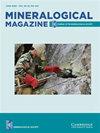用现代分析技术对锡钯石的再评价
IF 1.4
3区 地球科学
Q2 MINERALOGY
引用次数: 0
摘要
摘要对Fersman矿物学博物馆系统收藏的俄罗斯诺里尔斯克铜镍矿床Ugol’nyi Ruchei铂矿41647号样品进行了研究,发现其中含有一种矿物,可被鉴定为1947年描述的原始锡帕长石。由于关于后者的文献资料存在争议,因此使用现代分析技术对该矿物进行了重新研究。Stannopalladinite以高达0.08 mm的球形和卵形晶粒形式出现,与四铁铂紧密共生,成为长达6 mm的扁平棱柱状晶体的一部分。锡钯石(VHN, 30 g载荷)的微压痕硬度为244 kg/mm 2(范围233-266,n = 4),对应莫氏硬度为4。计算密度为9.781 g/ cm3。在反射光下,锡钯辉石呈淡粉色。双反射只有在油浸时才明显。在杂交镍中,矿物表现出较强的各向异性,颜色效果从红紫色变为灰蓝色,晶粒呈多合成孪晶。反射率曲线表现出明显的异常色散。化学成分(wt.%,电子探针数据,11次分析的平均值)为:Cu 8.48, Pd 61.21, Pt 0.89, Sn 25.87, Pb 3.70,总计100.15。以4个原子为单位计算得到的经验公式为(Pd 2.42 Cu 0.56 Pt 0.02) Σ3.00 (Sn 0.92 Pb 0.08) Σ1.00。因此,提出了锡钯铅矿的理想化学式为(Pd,Cu) 3sn,而不是IMA官方矿物清单中使用的Pd 3sn 2。最强的粉末x射线衍射线为[d obs, Å (I, %) (hkl)]: 2.292(42)(231)、2.166(100)(331)、2.034(10)(710)、1.916(15)(141)和1.851(15)(630)。粉末x射线数据在正交晶胞中进行标引,a = 14.634(2), b = 8.5253(6), c = 4.5946(3) Å, V = 573.24(7) Å 3(Z = 8)。结合化学、光学和x射线数据,可以在二元Pd-Sn和三元Pd-Cu-Sn体系的所有矿物中可靠地识别出Stannopalladinite。本文章由计算机程序翻译,如有差异,请以英文原文为准。
A re-evaluation of stannopalladinite using modern analytical techniques
Abstract An investigation of sample 41647 from the Platinum Placer of Ugol'nyi Ruchei, Norilsk Cu–Ni deposit, Russia, stored in the systematic collection of the Fersman Mineralogical Museum, revealed that it contained a mineral that can be identified as the original stannopalladinite described in 1947. As the literature information on the latter is controversial, the mineral was re-investigated using modern analytical techniques. Stannopalladinite occurs as spherical and ovoid-shaped grains up to 0.08 mm, closely intergrown with tetraferroplatinum as part of flattened, prismatic crystals up to 6 mm long. The micro-indentation hardness of stannopalladinite (VHN, 30 g load) is 244 kg/mm 2 (range 233–266, n = 4), corresponding to a Mohs hardness of 4. The calculated density is 9.781 g/cm 3 . In reflected light, stannopalladinite is pale pink. The bireflectance is noticeable only in oil immersion. In crossed nicols the mineral exhibits strong anisotropy with colour effects changing from reddish purple to greyish blue and polysynthetic twinning of grains. The reflectance curves show distinct anomalous dispersion. The chemical composition (wt.%, electron microprobe data, mean of 11 analyses) is: Cu 8.48, Pd 61.21, Pt 0.89, Sn 25.87, Pb 3.70, total 100.15. The empirical formula calculated on the basis of 4 atoms per formula unit is (Pd 2.42 Cu 0.56 Pt 0.02 ) Σ3.00 (Sn 0.92 Pb 0.08 ) Σ1.00 . The ideal chemical formula of stannopalladinite is therefore proposed as (Pd,Cu) 3 Sn instead of Pd 3 Sn 2 used in the official IMA List of Minerals. The strongest powder X-ray diffraction lines are [ d obs , Å ( I , %) ( hkl ) ]: 2.292 (42) (231), 2.166 (100) (331), 2.034 (10) (710), 1.916 (15) (141) and 1.851 (15) (630). The powder X-ray data are indexed in the orthorhombic unit cell with a = 14.634(2), b = 8.5253(6), c = 4.5946(3) Å and V = 573.24(7) Å 3 ( Z = 8). Stannopalladinite can be reliably identified among all other minerals belonging to the binary Pd–Sn and ternary Pd–Cu–Sn systems by a combination of chemical, optical and X-ray data.
求助全文
通过发布文献求助,成功后即可免费获取论文全文。
去求助
来源期刊

Mineralogical Magazine
地学-矿物学
CiteScore
4.00
自引率
25.90%
发文量
104
审稿时长
6-12 weeks
期刊介绍:
Mineralogical Magazine is an international journal of mineral sciences which covers the fields of mineralogy, crystallography, geochemistry, petrology, environmental geology and economic geology. The journal has been published continuously since the founding of the Mineralogical Society of Great Britain and Ireland in 1876 and is a leading journal in its field.
 求助内容:
求助内容: 应助结果提醒方式:
应助结果提醒方式:


